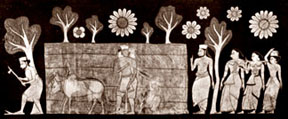|
observer |
|
|
|
|
|
OTHER LINKS |

|

|

|
|
|
|
|
It is at Medasiyapattuwa off Harasiyapattuwa in the District of Kandy, where the wonderful place known as Medawala Viharaya is situated. This shrine, housing a Buddha image, stands on a raised terrace built after an architectural style of that era, and has evolved around the 18th century.
This is a simple construction which rises from a grid of heavy double beams laid transversely (crossing each other) upon short monolith (large and upright) pillars, three feet to six feet in height. These pillars sink in to the ground and rest on a stone slab usually placed about two feet and six inches below ground level. This structure is very similar to the traditional granaries (atu bissa).
The shrine is rectangular, with roofs terminating in two finials (ornamental ends of roof). The shrine room, where the images are, is surrounded by a half wall of clay and wooden rails.
|
|
The origin of this temple of pillars is not certain. Just as barns were built on stone pillars to save the grain from white ants and other worms, so the image house on pillars may have arisen out of the need to protect the structure and statue from weather and decay.
The Medawala shrine is a two-storeyed building belonging to the fourteenth century, in the ancient site of Medawala. King Kirthi Sri Rajasinghe, who repaired it, converted it into a Viharageya-on-pillars.
The lower storey was of stone pillars; beams of timber were arranged across these pillars on a grid defined by the positions of the pillars. The upper storey was raised above this wooden grid on timber by the position of the pillars.
The building, however, had reached a state of decay, with its boarded wooden floor and walls in danger of collapse, when the Department of Archaeology undertook its conservation and completed the work in 1959.
The aesthetic beauty
|
|
The Medawala Viharaya contains some of the finest examples of mural paintings of the eighteenth century. There are some beautiful figures, including a statue of the Buddha seated under a decorated arch.
On the upper storey of the building, there are three seated Buddha images, ceiling paintings and 1196 figures on the walls. On the lower storey, there is an image of the Buddha seated on a 'vajrasana' (diamond throne) positioned under a thorana. Figures of various gods including Sakra, Brahma, Vishnu and Mahesvara, and incidents from the life of the Buddha, together with jataka stories (e.g. Temiya, Mahajanaka, Sama, Nimi, Khandala, Bhundatta, Mahanaradasa-kassapa and Vidura) were painted on the walls.
|
|
The architectural beautification of the edifices were completed with stone sculptures, including a flight of steps adorned with mythical figures and foliage patterns, flanked by two balustrades on which were figures of the elephant and lion (Gajasinghe). The steps began with a moonstone.
The framework of the huge wooden door is very complicated and fascinating. As one enters through this, they see the image of the Buddha. The figures of a pair of door-keepers (muragala), moulded in clay, guard the entrance.













